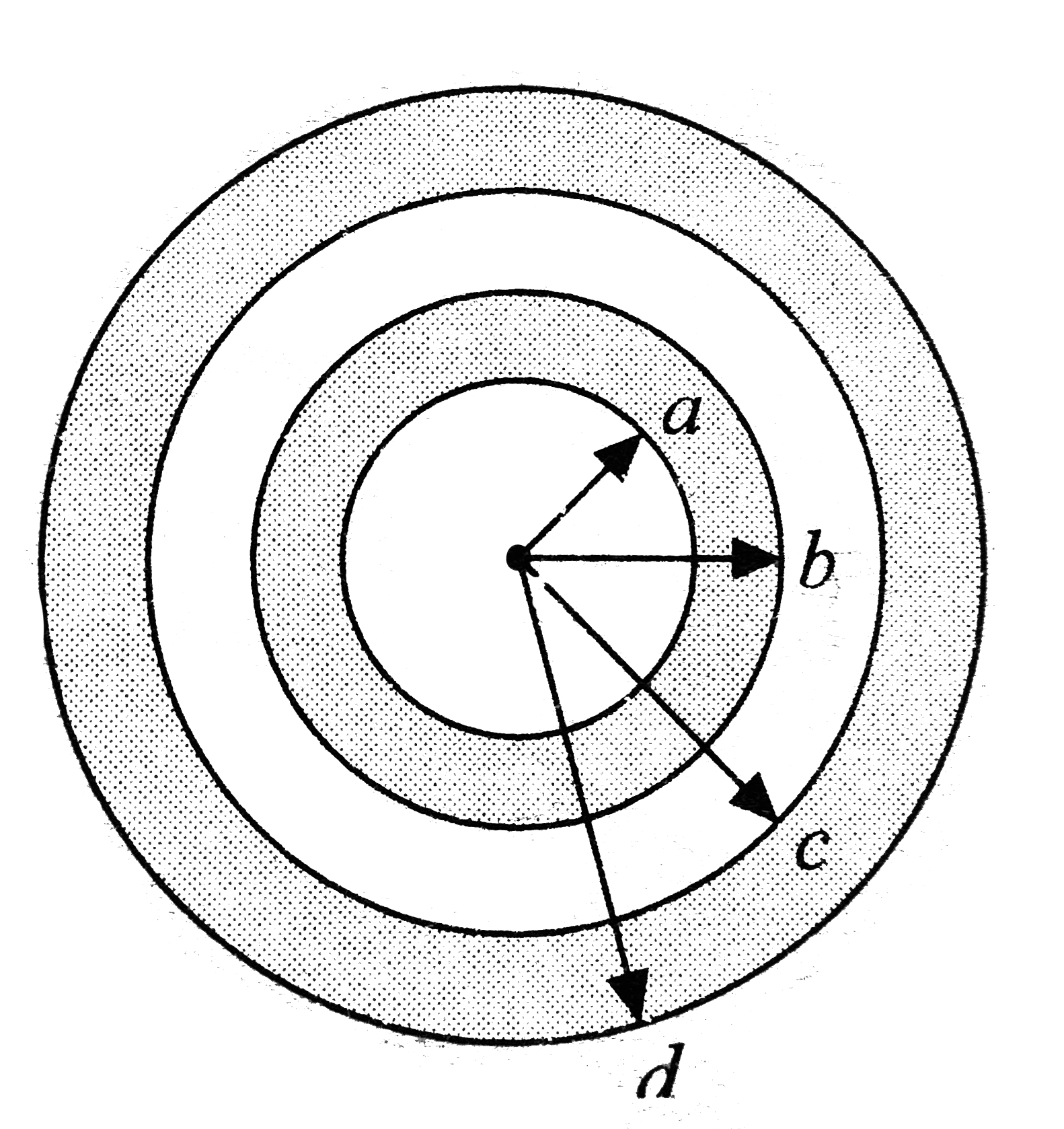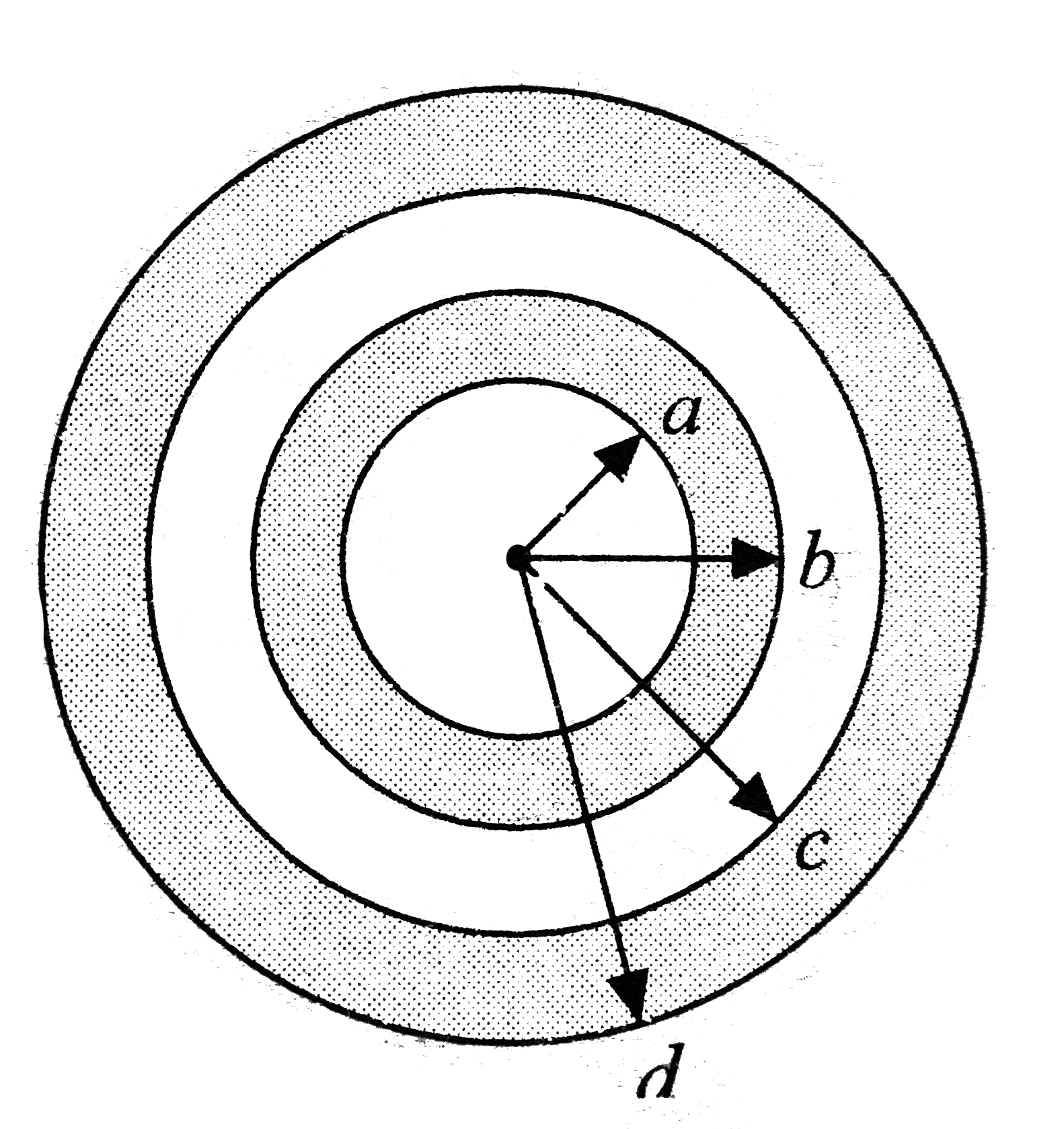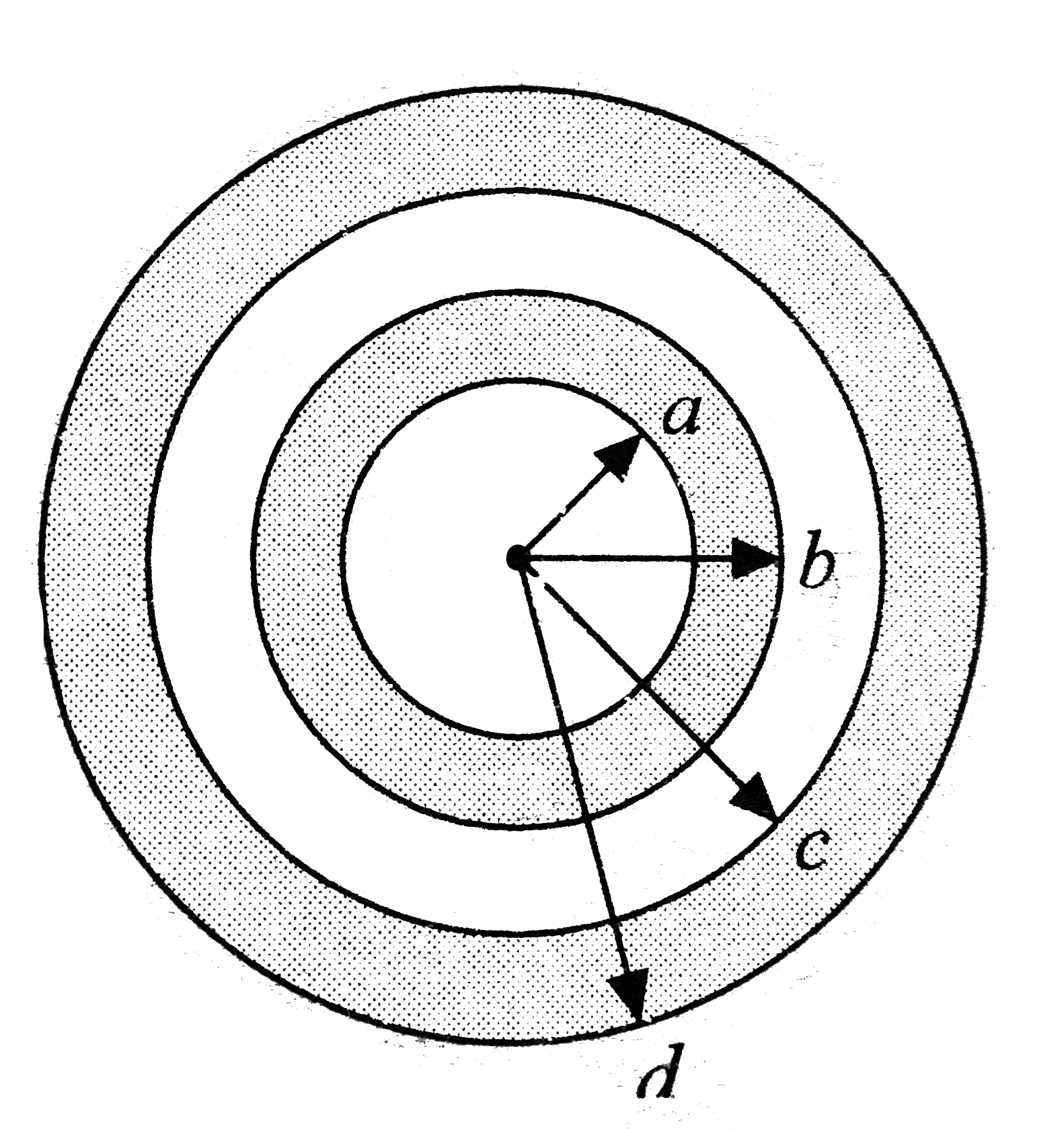Consider the previous problem , let the outer shell have the charge −4q. As in the above problem , the inner shell has the charge +2q. Calculate the electric field in terms of q and the distance r from the common center of the two shells for
zero
14πε02qr2
−14πε02qr2
14πε06qr2
The correct Answer is:C
To solve the problem of calculating the electric field in terms of q and the distance r from the common center of two shells, we will analyze the system step by step.
Step 1: Understand the Configuration
We have two concentric spherical shells:
- The inner shell has a charge of +2q.
- The outer shell has a charge of −4q.
Step 2: Identify Regions of Interest
We need to analyze the electric field in different regions:
1. Inside the inner shell (r < radius of inner shell)
2. Between the inner and outer shells (radius of inner shell < r < radius of outer shell)
3. Outside the outer shell (r > radius of outer shell)
Step 3: Electric Field Inside the Inner Shell (r < radius of inner shell)
According to Gauss's Law, the electric field inside a conductor is zero. Since the inner shell is a conductor and we are inside it, the electric field E is:
\( E = 0 \)
Step 4: Electric Field Between the Shells (radius of inner shell < r < radius of outer shell)
In this region, we will consider a Gaussian surface that is a sphere of radius r (where the radius is greater than that of the inner shell but less than that of the outer shell). The total charge enclosed by this Gaussian surface is the charge of the inner shell:
\( Q_{\text{enc}} = +2q \)
Using Gauss's Law:
\(
\Phi_E = \frac{Q_{\text{enc}}}{\epsilon_0} = E \cdot 4\pi r^2
\)
Substituting for \( Q_{\text{enc}} \):
\(
E \cdot 4\pi r^2 = \frac{2q}{\epsilon_0}
\)
Thus, the electric field \( E \) in this region is:
\(
E = \frac{2q}{4\pi \epsilon_0 r^2} = \frac{q}{2\pi \epsilon_0 r^2}
\)
Step 5: Electric Field Outside the Outer Shell (r > radius of outer shell)
In this region, the total charge enclosed by a Gaussian surface of radius r is the sum of the charges of both shells:
\(
Q_{\text{enc}} = +2q - 4q = -2q
\)
Using Gauss's Law again:
\(
E \cdot 4\pi r^2 = \frac{-2q}{\epsilon_0}
\)
Thus, the electric field \( E \) in this region is:
\(
E = \frac{-2q}{4\pi \epsilon_0 r^2} = \frac{-q}{2\pi \epsilon_0 r^2}
\)
Summary of Electric Field in Different Regions
1. For \( r < \) (radius of inner shell): \( E = 0 \)
2. For (radius of inner shell) < \( r < \) (radius of outer shell): \( E = \frac{q}{2\pi \epsilon_0 r^2} \)
3. For \( r > \) (radius of outer shell): \( E = \frac{-q}{2\pi \epsilon_0 r^2} \)
We have two concentric spherical shells:
- The inner shell has a charge of +2q.
- The outer shell has a charge of −4q.
We need to analyze the electric field in different regions:
1. Inside the inner shell (r < radius of inner shell)
2. Between the inner and outer shells (radius of inner shell < r < radius of outer shell)
3. Outside the outer shell (r > radius of outer shell)
According to Gauss's Law, the electric field inside a conductor is zero. Since the inner shell is a conductor and we are inside it, the electric field E is:
\( E = 0 \)
In this region, we will consider a Gaussian surface that is a sphere of radius r (where the radius is greater than that of the inner shell but less than that of the outer shell). The total charge enclosed by this Gaussian surface is the charge of the inner shell:
\( Q_{\text{enc}} = +2q \)
\(
\Phi_E = \frac{Q_{\text{enc}}}{\epsilon_0} = E \cdot 4\pi r^2
\)
Substituting for \( Q_{\text{enc}} \):
\(
E \cdot 4\pi r^2 = \frac{2q}{\epsilon_0}
\)
Thus, the electric field \( E \) in this region is:
\(
E = \frac{2q}{4\pi \epsilon_0 r^2} = \frac{q}{2\pi \epsilon_0 r^2}
\)
In this region, the total charge enclosed by a Gaussian surface of radius r is the sum of the charges of both shells:
\(
Q_{\text{enc}} = +2q - 4q = -2q
\)
\(
E \cdot 4\pi r^2 = \frac{-2q}{\epsilon_0}
\)
Thus, the electric field \( E \) in this region is:
\(
E = \frac{-2q}{4\pi \epsilon_0 r^2} = \frac{-q}{2\pi \epsilon_0 r^2}
\)
1. For \( r < \) (radius of inner shell): \( E = 0 \)
2. For (radius of inner shell) < \( r < \) (radius of outer shell): \( E = \frac{q}{2\pi \epsilon_0 r^2} \)
3. For \( r > \) (radius of outer shell): \( E = \frac{-q}{2\pi \epsilon_0 r^2} \)
Topper's Solved these Questions
- BOOK - CENGAGE PHYSICS ENGLISHCHAPTER - ELECTRIC FLUX AND GAUSS LAWEXERCISE - Subjective type7videos
ELECTRIC FLUX AND GAUSS LAW
- BOOK - CENGAGE PHYSICS ENGLISHCHAPTER - ELECTRIC FLUX AND GAUSS LAWEXERCISE - MCQ s38videos
ELECTRIC FLUX AND GAUSS LAW
- BOOK - CENGAGE PHYSICS ENGLISHCHAPTER - ELECTRIC FLUX AND GAUSS LAWEXERCISE - Multiple Correct8videos
ELECTRIC FLUX AND GAUSS LAW
- BOOK - CENGAGE PHYSICS ENGLISHCHAPTER - ELECTRIC CURRENT AND CIRCUITEXERCISE - Interger8videos
ELECTRIC CURRENT AND CIRCUIT
- BOOK - CENGAGE PHYSICS ENGLISHCHAPTER - ELECTRIC POTENTIALEXERCISE - DPP 3.515videos
ELECTRIC POTENTIAL
Similar Questions
A small conducting spherical shell with inner radius a and outer radius b is concentric with a larger conducting spherical shell with inner radius c and outer radius d ( as shown in Fig . 2.121). The inner shell has a total charge +2q, and the outer shell has a total charge +4q. Calculate the electric field in terms of q and the distance r from the common center of the two shells for

r<aView SolutionA small conducting spherical shell with inner radius a and outer radius b is concentric with a larger conducting spherical shell with inner radius c and outer radius d ( as shown in Fig . 2.121). The inner shell has a total charge +2q, and the outer shell has a total charge +4q. Calculate the electric field in terms of q and the distance r from the common center of the two shells for

b<r<cView SolutionA small conducting spherical shell with inner radius a and outer radius b is concentric with a larger conducting spherical shell with inner radius c and outer radius d ( as shown in Fig . 2.121). The inner shell has a total charge +2q, and the outer shell has a total charge +4q. Calculate the electric field in terms of q and the distance r from the common center of the two shells for

a<r<bView SolutionA small conducting spherical shell with inner radius a and outer radius b is concentric with a larger conducting spherical shell with inner radius c and outer radius d ( as shown in Fig . 2.121). The inner shell has a total charge +2q, and the outer shell has a total charge +4q. Calculate the electric field in terms of q and the distance r from the common center of the two shells for

c<r<dView SolutionA small conducting spherical shell with inner radius a and outer radius b is concentric with a larger conducting spherical shell with inner radius c and outer radius d. The inner shell has total charge +2q, and the outer shell has charge +4q. (K=(1)/(4piepsilon_(0)))

Find the electric field in terms of q and the distance r from the common centre of the two shells for (i) b<r<c (ii) c<r<dView SolutionA small conducting spherical shell with inner radius a and outer radius b is concentric with a larger conducting sphereical shell with inner radius c and outer radius d. The inner shell has total charge +2q and the outer shell has charge +4q.
a. Make a plot of the magnitude of the electric field versus r.
b. Calculate the electric field (magnitude and direction in terms of q) and the distance r from the common centre of the two shell for (i)r<a,(ii)a<r<b,(iii)bltrltc,(iv)cltrltd,(v)rgtd.Showuourrest–∈agraphwithradialcompo≠ntofvecEasfunctionofr.
c. What is the total charge on the
i. inner surface of the small shell,
ii. outer surface of the small shell,
iii. inner surface of the large shell,
iv. outer surface of the large shell?View SolutionA small conducting spherical shell with inner radius a and outer radius b is concentric with a larger conducting spherical shell with inner radius c and outer radius d. The inner shell has total charge +2q, and the outer shell has charge +4q. (K=(1)/(4piepsilon_(0)))

Find the electric in terms of q and the distance r from the common centre of the two shells for r>d.View SolutionA small conducting spherical shell with inner radius a and outer radius b is concentric with a larger conducting spherical shell with inner radius c and outer radius d. The inner shell has total charge +2q and the outer shell has charge +4q.
(i) What is the total charge on the (a) inner surface of the small shell, (b) outer surface of the small shell (c) inner surface of the large shell, (d) outer surface of the large shell ?
(ii) Calculate the electric field in terms of q and the the distance r from the common centre of two shells for (a) r<a, (b) a<r<b, (c) b<r<c, (d) c<r<d, (e) r>d
 View Solution
View SolutionA conducting shell of radius R carries charge −Q. A point charge +Q is placed at the centre. The electric field E varies with distance r (from the centre of the shell) as
View SolutionConsider the situation of the previous problem. The force on the central charge due to the shell is
View Solution

